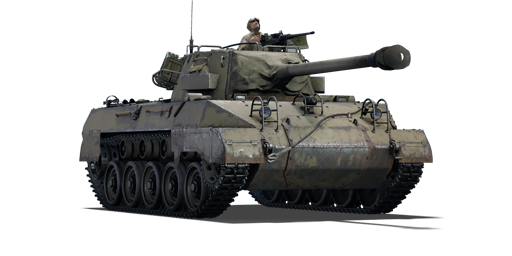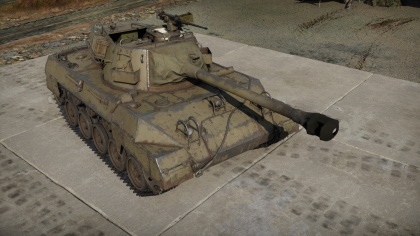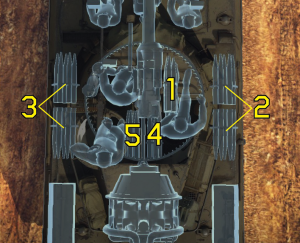M18 GMC
Contents
| This page is about the tank destroyer M18 GMC. For the premium version, see M18 "Black Cat" |
Description
The M18 Gun Motor Carriage, also known as the M18 GMC, is a Rank III American tank destroyer
with a battle rating of 5.3 (AB) and 6.0 (RB/SB). It was introduced in Update 1.49 "Weapons of Victory". The M18 "Hellcat" was the epitome of the American tank destroyer doctrine, it was very fast, very mobile, and has a powerful gun, though with a large trade-off with only 12.7 mm (0.5 inches) of armour.
The M18 "Hellcat" compensates the lack of anti-tank capability on U.S vehicles by having access to a 76 mm gun with APCR ammunition, all in the battle rating of 4.7. This makes the M18 able to fight off many of the high-ranking vehicles it could face like the Panther D, Tiger H1, KV-1, KV-85, and IS-1.
Unlike the other tank destroyers known in the game, the M18 "Hellcat" has access to a 360° traversable turret, allowing players to have a greater arc of fire than a typical casemate tank destroyer like the StuG III, but at the expense of a slightly higher profile. Americans tank destroyers also have very high maneuverability compared to other nation's tank destroyers, allowing it to flank the enemy.
The main weak point of M18 is its very thin armour, a feature that actually allows the M18 to reach its high speed. The thin armour makes it possible for any enemy tanks to penetrate the vehicle. A single hit would destroy many critical components in the M18 or cripple the crew. The only saving grace with this extremely thin ammunition is that standard AP rounds may overpenetrate the armour, doing minimal damage to the internals. Thus, when facing the M18, its best to use AP rounds with explosive fillers or HE and HEAT rounds while avoiding usage of pure AP rounds and APCR.
General info
Survivability and armour
Armour type:
- Rolled homogeneous armour
- Cast homogeneous armour (Gun mantlet)
| Armour | Front (Slope angle) | Sides | Rear | Roof |
|---|---|---|---|---|
| Hull | 12.7 mm (39-64°) Front glacis 12.7 mm (23-52°) Lower glacis |
12.7 mm (23-26°) Top 12.7 mm Bottom |
12.7 mm (12°) Top 12.7 mm (36°) Bottom |
8 mm |
| Turret | 25.4 mm (15-26°) Turret front 19 mm + 25.4 mm (0-55°) Gun mantlet |
12.7 mm (1-21°) | 12.7 mm (7°) | N/A Open-top 8 mm Bustle and Front |
Notes:
- Suspension wheels and tracks are 15 mm thick.
- Belly armour is 5 mm thick.
- The hull underside right above the tracks are only 8 mm thick.
- Tracks are attached the the turret rear, granting some 15 mm in thickness.
Mobility
| Mobility characteristic | ||
|---|---|---|
| Weight (tons) | Add-on Armor weight (tons) |
Max speed (km/h) |
| 17.7 | N/A | 79 (AB) |
| 72 (RB/SB) | ||
| Engine power (horsepower) | ||
| Mode | Stock | Upgraded |
| Arcade | 653 | 804 |
| Realistic/Simulator | 407 | 460 |
| Power-to-weight ratio (hp/ton) | ||
| Mode | Stock | Upgraded |
| Arcade | 36.89 | 45.42 |
| Realistic/Simulator | 22.99 | 25.99 |
Armaments
Main armament
| 76 mm M1 | |||||
|---|---|---|---|---|---|
| Capacity | Vertical guidance |
Horizontal guidance |
Stabilizer | ||
| 45 | -10°/+20° | ±180° | N/A | ||
| Turret rotation speed (°/s) | |||||
| Mode | Stock | Upgraded | Prior + Full crew | Prior + Expert qualif. | Prior + Ace qualif. |
| Arcade | 14.28 | 19.80 | 24.0 | 26.60 | 28.20 |
| Realistic | 14.28 | 16.80 | 20.4 | 22.60 | 24.00 |
| Reloading rate (seconds) | |||||
| Stock | Prior + Full crew | Prior + Expert qualif. | Prior + Ace qualif. | ||
| 7.93 | 7.02 | 6.47 | 6.10 | ||
Ammunition
| Penetration statistics | |||||||
|---|---|---|---|---|---|---|---|
| Ammunition | Type of warhead |
Penetration in mm @ 90° | |||||
| 10m | 100m | 500m | 1000m | 1500m | 2000m | ||
| M62 Shell | APCBC | 127 | 125 | 116 | 106 | 97 | 89 |
| M42A1 Shell | HE | 7 | 7 | 7 | 7 | 7 | 7 |
| M79 Shot | AP | 155 | 154 | 131 | 107 | 88 | 72 |
| M93 Shot | APCR | 221 | 215 | 203 | 181 | 154 | 124 |
| Shell details | ||||||||||
|---|---|---|---|---|---|---|---|---|---|---|
| Ammunition | Type of warhead |
Velocity in m/s |
Projectile Mass in kg |
Fuse delay
in m: |
Fuse sensitivity
in mm: |
Explosive Mass in g (TNT equivalent): |
Normalization At 30° from horizontal: |
Ricochet: | ||
| 0% | 50% | 100% | ||||||||
| M62 Shell | APCBC | 792 | 7 | 1.2 | 20 | 63.7 | +4° | 48° | 63° | 71° |
| M42A1 Shell | HE | 800 | 5.8 | 0.1 | 0.5 | 390 | +0° | 79° | 80° | 81° |
| M79 Shot | AP | 792 | 6.8 | N/A | N/A | N/A | -1° | 47° | 60° | 65° |
| M93 Shot | APCR | 1036 | 4.3 | N/A | N/A | N/A | +1.5° | 66° | 70° | 72° |
Ammo racks
| Full ammo |
1st rack empty |
2nd rack empty |
3rd rack empty |
4th rack empty |
5th rack empty |
Visual discrepancy |
|---|---|---|---|---|---|---|
| 45 | 37 (+8) | 27 (+18) | 17 (+28) | 9 (+36) | 1 (+44) | No |
Machine guns
| 12.7 mm M2HB | ||||||
|---|---|---|---|---|---|---|
| Pintle mount | ||||||
| Capacity (Belt capacity) | Fire rate (shots/minute) |
Vertical guidance |
Horizontal guidance | |||
| 800 (200) | 576 | -10°/+70° | ±60° | |||
Usage in the battles
Before all, avoid colorful or bright decals. Camouflage is a main part of the M18's defense. Chances for good performance in battle are: be "invisible", fast and effective. The M18's speed is its best ally. This speed has to be used for flanking maneuvers and relocate. Not for trying to cross open field, that will leave it open to enemy fire, speed is not a substitute for armour.
Relocate: This movement will have to be done again and again. Choose a good spot wisely, remove the foliage if necessary to get a clear field of fire. When in the fire spot, use the gun depression and stay in a hull down position until a target is located. Once a target is locked on, aim at critical components. Try to immobilize the enemy by firing at the engine or transmission, or remove their firepower by shooting the gun or breech, or for an instant destruction with a shot to the ammo storage. The last option can work very well or not, as skilled players only carry a few rounds of ammo.
If positive that the enemy hasn´t discovered the firing spot, go for another shot. Stay attentive that none of the enemy's teammates have also located the firing spot. If detected, hide immediately and relocate.
Flanking: Flanking is the most dangerous maneuver of all because the vehicle will have to be exposed as it moves to the enemy's rear, but it is very effective when it's coordinated with other vehicles. A distraction is needed to gain the enemy's attention while the M18 makes its move. Isolated enemy units are very vulnerable to this tactic. Using the M18 speed to get to the rear and as the enemy heads toward the objective, the firing perspective should give a very clear view of the enemy's side armour. A good shot with the M62 APCBC shell could knock out the enemy rather quickly, but if using solid AP shots like the M79, aim at critical components on mobility and firepower before knocking out the crew or ammo stowage.
Avoid flat terrain: Flat terrain means that the Hellcat will become an easy target for virtually any vehicle by exposure, especially when not moving or when moving in a straight line. Open plains are the bane of the Hellcat. Whenever possible, one should try to stay amongst hills.
Pros and cons
Pros:
- Fast.
- Low profile.
- APCR shells have a very high penetration.
- Good power to weight ratio.
- Excellent mobility permits flanking tactics and unconventional sniping spots.
- Deadly flanker.
- Effective 76 mm gun.
- Very fast reverse.
- Fast turret rotation speed.
- Fast reload speed.
- Light weight and extreme mobility permits the use of "Mountain Hellcat" tactics.
- Any AP rounds have a tendency of passing through the thin armour with no other damages unless aimed at the crew and modules, even APHE may not be triggered on a hit.
- Front armour can cause some stray shells to ricochet off.
- British tanks will have a hard time destroying the M18 with solid AP rounds.
- Enemy players often see the tank as an easy target regardless of point-of-impact, leading players to aim carelessly and bounce rounds off of an otherwise badly armoured vehicle.
Cons:
- Weak armour. This can be easily penetrated by heavy machine guns and aircraft weapons.
- Commander mans the .50 cal and therefore is exposed.
- Stock shells are inadequate against heavily armoured foes.
- A damaged/disabled engine leaves the vehicle a sitting target.
- SPAAs can destroy the M18 really quickly.
- Open top which exposes the crew to machine gun fire and shrapnel.
- Very vulnerable to artillery barrages.
- Prone to HE and HEAT shells.
History
US Tank Destroyer Doctrine
The anti-tank doctrine established by the US military called for fast, powerful vehicles able to stop the German blitzkrieg tactics by ambushing the attacking tank forces. This doctrine, known as the "Tank Destroyer Doctrine", called for anti-tank forces to be held in the reserves anticipating for the massed tank attack that the Germans have been using to run over France. However, the issue with this is that the front-line forces would be left vulnerable without any anti-tank weaponry at hand. The solution was to keep a few anti-tank guns in the front-line as the first defense, while a large reserve of mobile tank destroyers would move in at the location where a German tank breakthrough is happening to ambush and destroy the enemy force. This role led to the desire for a fast vehicle with a powerful gun, armour was not a concern due to the emphasis in speed. The initial response was the M10 GMC, made form the M4 Sherman hull and mounting a 3-inch M1918 gun. While adequate at this role, it was no faster than an ordinary Sherman tank. The M18 Gun Motor Carriage was a response to the problem to provide the tank destroyer force with a very fast tank destroyer.[1]
Development
The origin of the M18 design came as early as December 1941 with the requirement of a Christie suspension and a 37 mm gun. This requirement called for a radical new tank design rather than a derivative of the M4 Sherman. These requirements changed as the war progressed, the first change was to the new and innovative Torsion bar suspension from Buick Motor Division from General Motors and another change was to mount the British QF 6-pounder gun then in use on their Churchill Mark III tanks, the developed prototype vehicle was called the T49 GMC. Then the US Army wanted the heavier 75 mm gun used on the Shermans on it, this prototype was designated the T67 GMC. Finally, the army decided to mount the 76 mm gun also in development for the Sherman onto the prototype, now known as T70 GMC. Changes to hull shape and turret took place to accommodate all these new requirements and armament, but it eventually was approved for service and finally renamed as the M18 GMC and started production in mid-1943, which went on until ending in October 1944 with 2,507 units produced. A variant called the M39 Armored Utility Vehicle was also produced, its turret was removed for space for cargo, 8 personnel, or to tow guns.
Combat usage
These vehicles saw combat debut in the summer of 1944, where they are given the unofficial nickname "Hellcat" by the crews using them. Unlike the M10 tank destroyer that was built before it, the M18 GMC was purely made for emphasis on speed. Armour was restricted down to a maximum of 1-inch (25 mm) on the turret front while the rest of the body plating are a measly .50-inches thick (12.7 mm). The turret was also an open-top design similar to the M10 tank destroyer, meaning the crew are left exposed to the elements and enemy fire and shrapnel. These faults were mitigated by the fact that as its role as an tank destroyer, it was to have minimum contact with infantry and ambush enemy tanks in concealed position rather than face them in an offensive operation. Nevertheless, the M18 GMC were well liked by the crew for its 76 mm cannon, which allows it to destroy the newer German Tiger Is and Panthers tanks from the front with HVAP ammo (though the Panther at close range only) when unable to flank around to the side or rear of these tanks. The speed was also astounding, reaching 55 miles per hour maximum, this makes the M18 GMC the fastest armoured fighting vehicle in World War II.
While use in the Pacific theater was limited due to the inadequate armour of Japanese tanks, it saw most of its service in the European theater against Nazi Germany. Due to the lack in armour and emphasis on speed, the M18 crews utilize the "shoot and scoot" tactic in attacking the enemy from one position and quickly move to another before the enemy could find their initial firing position, this tactic confuses the German tanks, and could even lead them to believe there are more armoured enemy than what it appears. The M18 GMCs were present during the Battle of Arracourt in France as the 704th Tank Destroyer Battalion. Lt. Edwin Leiper led an M18 platoon of C Company and in the battle knocked a total of 15 German tanks for the loss of three M18; six of these German tank kills, most of which were Panthers, were credited to one M18 led by Sgt Henry R. Hartman. The M18 also played a crucial part in the Battle of the Bulge, where its top speed of 55 mph was finally put to good use in bypassing the enemy forces. Four M18 tank destroyers of the 705th Tank Destroyer Battalion assisted the 506th Parachute Infantry Regiment in attacking the 2nd Panzer Divison and their support to kill the fuel lines to the German tanks. The overall attack had the M18 GMCs credited with at least 24 tank kills of the 30 total inflicted in the attack.
Legacy
Overall, the M18 GMCs proved itself by having the highest kill to loss ratio to any other tanks and tank destroyer in American service, making it the most effective tank destroyer in American service. However, like its other tank destroyer brethens, it soon found itself obsolete along with the entire tank destroyer doctrine. Mainly due to increasing prevalence of well-armoured tanks that could do its job more efficiently such as the M26 Pershing, but also the lack of German AFVs at the time of the war and a study on ammo usage indicates that the tank destroyers spent more time supporting infantry with high-explosive shells than killing tanks with armour-piercing, rendering the anti-tank section an unecessary component in the modernizing armoured forces.
Today, some countries in the world such as Yugoslavia still have the M18 Hellcats in reserves.
Media
Skins and camouflages for the M18 Hellcat series from live.warthunder.com.
References
- ↑ Zaloga Steven. M18 Hellcat Tank Destroyer 1943-97 Great Britain: Osprey Publishing Ltd., 2004
Read also
[Devblog] M18 and M18 'Black Cat'
[Vehicle Profile] As fast as deadly: The M18 Hellcat
[Profile] M18 Gun Motor Carriage – Hellcat
Sources
Paste links to sources and external resources, such as:
- topic on the official game forum;
- other literature.
| USA tank destroyers | |
|---|---|
| M10 | M10 GMC |
| M36 | M36 GMC · M36B2 |
| T95 | T28 · T95 |
| M109 | M109A1 |
| ATGM | LOSAT · M901 |
| Wheeled | M3 GMC · T55E1 |
| Other | M8 HMC · M50 · M56 |
| China | ▃LVT(A)(4) (ZIS-2) |






